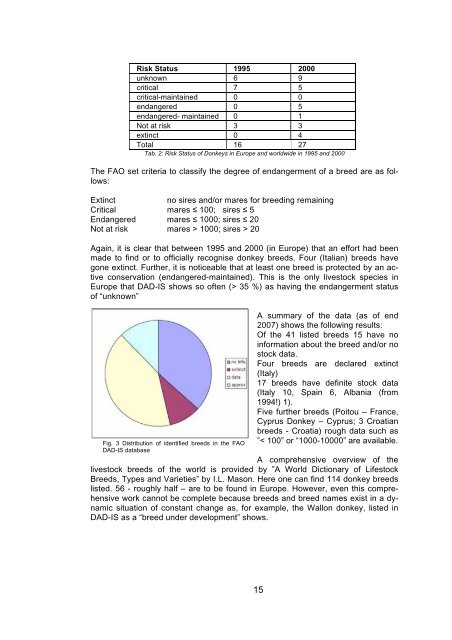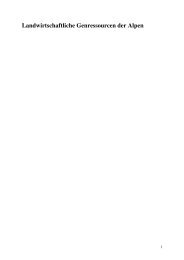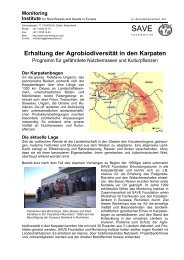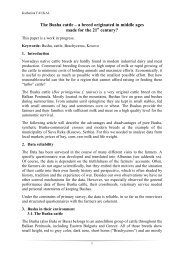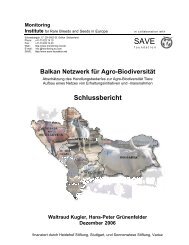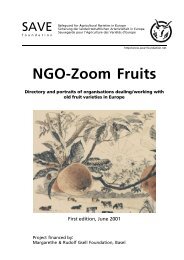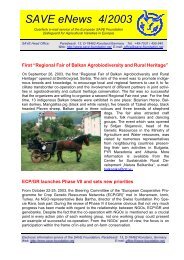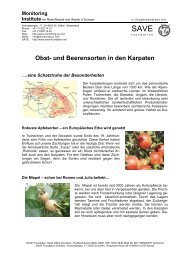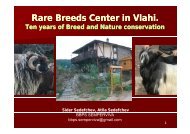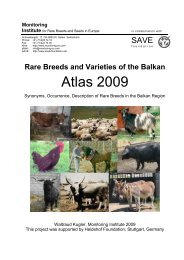Donkey Breeds in Europe - Safeguard for Agricultural Varieties in ...
Donkey Breeds in Europe - Safeguard for Agricultural Varieties in ...
Donkey Breeds in Europe - Safeguard for Agricultural Varieties in ...
Create successful ePaper yourself
Turn your PDF publications into a flip-book with our unique Google optimized e-Paper software.
Risk Status 1995 2000<br />
unknown 6 9<br />
critical 7 5<br />
critical-ma<strong>in</strong>ta<strong>in</strong>ed 0 0<br />
endangered 0 5<br />
endangered- ma<strong>in</strong>ta<strong>in</strong>ed 0 1<br />
Not at risk 3 3<br />
ext<strong>in</strong>ct 0 4<br />
Total 16 27<br />
Tab. 2: Risk Status of <strong>Donkey</strong>s <strong>in</strong> <strong>Europe</strong> and worldwide <strong>in</strong> 1995 and 2000<br />
The FAO set criteria to classify the degree of endangerment of a breed are as follows:<br />
Ext<strong>in</strong>ct no sires and/or mares <strong>for</strong> breed<strong>in</strong>g rema<strong>in</strong><strong>in</strong>g<br />
Critical mares � 100; sires � 5<br />
Endangered mares � 1000; sires � 20<br />
Not at risk mares > 1000; sires > 20<br />
Aga<strong>in</strong>, it is clear that between 1995 and 2000 (<strong>in</strong> <strong>Europe</strong>) that an ef<strong>for</strong>t had been<br />
made to f<strong>in</strong>d or to officially recognise donkey breeds. Four (Italian) breeds have<br />
gone ext<strong>in</strong>ct. Further, it is noticeable that at least one breed is protected by an active<br />
conservation (endangered-ma<strong>in</strong>ta<strong>in</strong>ed). This is the only livestock species <strong>in</strong><br />
<strong>Europe</strong> that DAD-IS shows so often (> 35 %) as hav<strong>in</strong>g the endangerment status<br />
of “unknown”<br />
Fig. 3 Distribution of identified breeds <strong>in</strong> the FAO<br />
DAD-IS database<br />
A summary of the data (as of end<br />
2007) shows the follow<strong>in</strong>g results:<br />
Of the 41 listed breeds 15 have no<br />
<strong>in</strong><strong>for</strong>mation about the breed and/or no<br />
stock data.<br />
Four breeds are declared ext<strong>in</strong>ct<br />
(Italy)<br />
17 breeds have def<strong>in</strong>ite stock data<br />
(Italy 10, Spa<strong>in</strong> 6, Albania (from<br />
1994!) 1).<br />
Five further breeds (Poitou – France,<br />
Cyprus <strong>Donkey</strong> – Cyprus; 3 Croatian<br />
breeds - Croatia) rough data such as<br />
”< 100” or “1000-10000” are available.<br />
A comprehensive overview of the<br />
livestock breeds of the world is provided by ”A World Dictionary of Lifestock<br />
<strong>Breeds</strong>, Types and <strong>Varieties</strong>” by I.L. Mason. Here one can f<strong>in</strong>d 114 donkey breeds<br />
listed. 56 - roughly half – are to be found <strong>in</strong> <strong>Europe</strong>. However, even this comprehensive<br />
work cannot be complete because breeds and breed names exist <strong>in</strong> a dynamic<br />
situation of constant change as, <strong>for</strong> example, the Wallon donkey, listed <strong>in</strong><br />
DAD-IS as a “breed under development” shows.<br />
15


